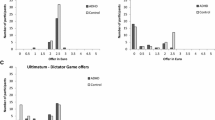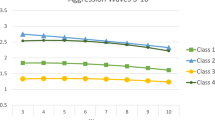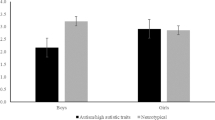Abstract
This study explores the social impact of ADHD, with and without opposition-defiant behaviour (ADHD+ODD (n= 22) and ADHD-only (n= 18)), in 9- to 12- year old girls compared to girls without ADHD (n= 40). Girls played a computer game involving simulated players, and mothers and teachers completed rating scales. In general, mothers and teachers saw girls with ADHD+ODD as more overtly and relationally aggressive and less prosocial than girls with ADHD-only, who were seen as more overtly and relationally aggressive and less prosocial than control girls. On the computer game, girls with ADHD+ODD were more overtly aggressive, more directly relationally aggressive, and showed less skilled behaviour than the other groups. Girls with ADHD-only showed less covert, indirect relational aggression and more socially awkward interactions than girls in the control group on the computer game. In all, the results indicate that girls with ADHD, with and without ODD behaviour, engage in socially detrimental behaviours.
Similar content being viewed by others
References
Abikoff, H. B., Jensen, P. S., Arnold, L. L. E., Hoza, B., Hechtman, L., Pollack, S., et al. (2002). Observed classroom behavior of children with ADHD: Relationship to gender and comorbidity. Journal of Abnormal Child Psychology, 30, 349–359.
Achenbach, T. M.,(1991). Manual for the child behavior checklist/4-18 and 1991 profile. Burlington, VT: University of Vermont Department of Psychiatry.
American Psychiatric Association (2000). Diagnostic and statistical manual of mental disorders, 4th edition (DSM-IV)—Text revision. Washington, DC: American Psychiatric Association.
Atkins, M. S., & Stoff, D. M. (1993). Instrumental and hostile aggression in childhood disruptive behavior disorders. Journal of Abnormal Child Psychology, 21, 165–178.
Barkley, R. A. (2006). Attention deficit hyperactivity disorders: A handbook for diagnosis and treatment (3rd ed.). New York: Guilford Press.
Biederman, J., Mick, E., Faraone, S. V., Braaten, E., Doyle, A., Spencer, T., et al. (2002). Influence of gender on attention deficit hyperactivity disorder in children referred to a psychiatric clinic. American Journal of Psychiatry, 159, 36–42.
Björkqvist, K., Lagerspetz, K. M. J., & Kaukiainen, A. (1992). Do girls manipulate and boys fight? Developmental trends in regard to direct and indirect aggression. Aggressive Behavior, 18, 117–127.
Blachman, D. R., & Hinshaw, S. P. (2002). Patterns of friendship among girls with and without ADHD. Journal of Abnormal Child Psychology, 30, 625–640.
Carlson, C. L., Tamm, L., & Gaub, M. (1997). Gender differences in children with ADHD, ODD, and co-occurring ADHD/ODD identified in a school population. Journal of the American Academy of Child and Adolescent Psychiatry, 36, 1706–1714.
Crick, N. R. (1996). The role of overt aggression, relational aggression, and prosocial behaviour in the prediction of children’s future social adjustment. Child Development, 67, 2317–2327.
Crick, N. R. (1997). Engagement in gender normative versus nonnormative forms of aggression: Links to social-psychological adjustment. Developmental Psychology, 33, 610–617.
Crick, N. R., & Grotpeter, J. K. (1995). Relational aggression, gender, and social-psychological adjustment. Child Development, 66, 710–722.
DuPaul, G. J., Power, T. J., Anastopoulos, A. D., & Reid, R. (1998). ADHD Rating Scale-IV Checklists, Norms, and Clinical Interpretation. New York: Guilford Press.
Erhardt, D., & Hinshaw, S. P. (1994). Initial sociometric impressions of hyperactive and comparison boys: Predictions from social behaviours and from nonbehavioral variables. Journal of Consulting and Clinical Psychology, 62, 833–842.
Frick, P. J. & Loney, B. (2000). The use of laboratory and performance-based measures in the assessment of children and adolescents with conduct disorders. Journal of Clinical Child Psychology, 29, 540–554.
Gaub, M., & Carlson, C. L. (1997). Gender differences in ADHD: A meta-analysis and critical review. Journal of the American Academy of Child and Adolescent Psychiatry, 36, 1036–1045.
Greene, R. W., Biederman, J., Faraone, S. V., Monuteaux, M. C., Mick, E., DuPre, E. P., et al. (2001). Social impairment in girls with ADHD: Patterns, gender comparisons, and correlates. Journal of the American Academy of Child and Adolescent Psychiatry, 40, 704–710.
Hinshaw, S. P. (2002). Preadolescent girls with attention-deficit/hyperactivity disorder: I. Background characteristics, comorbidity, cognitive and social functioning, and parenting practices. Journal of Consulting and Clinical Psychology, 70, 1086–1098.
Holm, S. (1979). A simple sequentially rejective multiple test procedure. Journal of Statistics, 6, 65–70.
Hommersen, P., Murray, C., Ohan, J. L., & Johnston, C. (2006). The Oppositional Defiant Disorder Rating Scale: Preliminary evidence of reliability and validity. Journal of Emotional and Behavioral Disorders, 14, 118–125.
Maccoby, E. E. (1998). The two sexes: Growing up apart, coming together. Cambridge, MA: Belknap-Harvard University Press.
Murphy, D. A., Pelham, W. E., & Lang, A. R. (1992). Aggression in boys with attention deficit hyperactivity disorder: Methylphenidate effects on naturalistically observed aggression, response to provocation, and social information processing. Journal of Abnormal Child Psychology, 20, 451–466.
Ohan, J. L., & Johnston, C. (2005). Gender appropriateness of symptom criteria for attention-deficit/hyperactivity disorder, oppositional-defiant disorder, and conduct disorder. Child Psychiatry and Human Development, 35, 359–381.
Rubin, K. H., Bukowski, W., & Parker, J. G. (1998). Peer interactions, relationships, and groups. In N. Eisenberg (Ed.), Handbook of child psychology: Vol. 3. Social, emotional, and personality development (pp. 619–700). New York: Wiley & Sons.
Silverthorn, Frick, P. J., Kuper, D., & Ott, J. (1996). Attention deficit hyperactivity disorder and sex: A test of two etiological models to explain the male predominance. Journal of Clinical Child Psychology, 25, 52–59.
Zalecki, C. A., & Hinshaw, S. P. (2004). Overt and relational aggression in girls with ADHD. Journal of Clinical Child and Adolescent Psychology, 33, 125–137.
Author information
Authors and Affiliations
Corresponding author
Rights and permissions
About this article
Cite this article
Ohan, J.L., Johnston, C. What is the Social Impact of ADHD in Girls? A Multi-Method Assessment. J Abnorm Child Psychol 35, 239–250 (2007). https://doi.org/10.1007/s10802-006-9076-1
Received:
Accepted:
Published:
Issue Date:
DOI: https://doi.org/10.1007/s10802-006-9076-1




